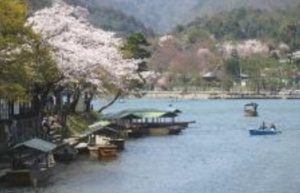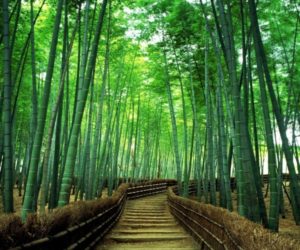Your private guide will pick you up at your hotel and together you will then head to the Arashiyama district, a pleasant district in the western outskirts of Kyoto. It is blessed with magnificent natural biodiversity and an intriguing history. The area has been a popular destination since the Heian Period (794-1185), when nobles would enjoy its natural setting.

You will visit Okochi Mountain Villa. It is the former villa of the popular samurai film star Okochi Denjiro (1896-1962), and consists of several beautiful gardens and buildings, including living quarters, tea houses and a zen meditation hall.
Here you will enjoy some matcha green tea with a snack.
Next, take a walk through the Arashiyama’s famous and beautiful bamboo groves. The bamboo has been used to manufacture various products, such as baskets, cups, boxes and mats at local workshops for centuries.

Afterwards you will go to Nonomiya shrine which has a fascinating History. It is a Shinto shrine where in ancient times, unmarried imperial princesses stayed for a year or more to purify themselves.
Head to the lovely Tenryuji, the largest and most impressive temple in Arashiyama, which is ranked among Kyoto’s five great Zen temples. Founded in 1339 at the beginning of the Muromachi Period, the temple is one of Kyoto’s UNESCO World Heritage Sites. In addition to its temple buildings, there are attractive gardens with walking paths.
In a traditional building inside the temple grounds overlooking the beautifully landscaped garden, enjoy a beautiful vegetarian shojin-ryori lunch (traditional Buddhist cuisine) built around yuba, tofu and seasonal vegetables.
After lunch, you will head to Arashiyama Monkey Park.
A short ten minutes walk uphill is needed in order to reach an open area with over a hundred monkeys roaming freely. There are also nice views down onto the city.

End your day with a ride on the Sagano Scenic Railway, also known as the Romantic Train.
It is a sightseeing train line that runs along the Hozugawa River between Arashiyama and Kameoka. Its charming, old fashioned trains wind their way through the mountains at a relatively slow pace, taking about 25 minutes to make the seven-kilometer journey and giving passengers a pleasant view of the scenery as they travel from rural Kameoka through the forested ravine and into Arashiyama.
After this peaceful day, you will then go back to Kyoto with your private guide who will drop you off at your hotel. Public Transport tickets are included in this tour.
* This tour operates from March 1 to December 29.







